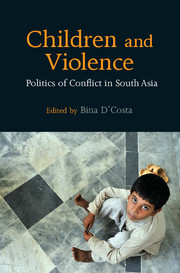Book contents
- Frontmatter
- Dedication
- Contents
- List of Map, Figures and Tables
- Acknowledgements
- Introduction: ‘Turtles Can Fly’: Vicarious Terror and the Child in South Asia
- Part I Shaping Childhood in South Asia
- Part II Conflict and Violent Peace
- Part III Rights, Needs and Protection
- 8 Children Affected by Political Violence in India: Human Rights, Politics and Protection
- 9 Rethinking Rights and Needs: The Everyday Life of Refugee Children in the Borderland
- 10 Pinning Down a Paper Tiger: Some Practice Observations on the Monitoring and Reporting Mechanism in Nepal and Asian Contexts
- Part IV Reflections from Human Rights Advocates in the Region
- Bibliography
- Notes on Contributors
- Index
8 - Children Affected by Political Violence in India: Human Rights, Politics and Protection
from Part III - Rights, Needs and Protection
Published online by Cambridge University Press: 05 June 2016
- Frontmatter
- Dedication
- Contents
- List of Map, Figures and Tables
- Acknowledgements
- Introduction: ‘Turtles Can Fly’: Vicarious Terror and the Child in South Asia
- Part I Shaping Childhood in South Asia
- Part II Conflict and Violent Peace
- Part III Rights, Needs and Protection
- 8 Children Affected by Political Violence in India: Human Rights, Politics and Protection
- 9 Rethinking Rights and Needs: The Everyday Life of Refugee Children in the Borderland
- 10 Pinning Down a Paper Tiger: Some Practice Observations on the Monitoring and Reporting Mechanism in Nepal and Asian Contexts
- Part IV Reflections from Human Rights Advocates in the Region
- Bibliography
- Notes on Contributors
- Index
Summary
When one thinks about children and armed violence, the first image that tends to come to mind is that of a child soldier or a refugee child who has been subjected to the horror of adult wars. This is an image that one does not associate with a vibrant democracy such as India – although growing international attention to the Naxalite insurgents’ use of child soldiers is starting to tarnish this image. This chapter approaches the issue of children affected by armed violence from a different perspective; that of communal violence, to challenge the way that people think about children's human rights and protection of those rights during periods of targeted political violence on the basis of religious or other identity-based differences.
International Humanitarian Law (IHL) has long made special provisions for the protection of children in armed conflicts, and legal and normative developments have come a long way in regulating the protection of children in today's unconventional armed conflicts. Over the past two decades, concern over children affected by armed conflict has become a high profile issue on the United Nations Security Council agenda in particular. However, there are many children in India that are directly impacted by one-sided, targeted violence outside international and non-international armed conflicts as defined by IHL.
One of the contentions in this chapter is to argue that the vocabulary, and the legal and institutional framework for addressing children's protection issues arising from political violence continue to reside outside either the domain of armed conflict,1 or social welfare-oriented responses by the Indian State. Accordingly, this chapter seeks to conceptualize the specific issue of children affected by political violence in India within this ambiguous terrain. Although communal violence may affect a small percentage of India's children, the nature of violence suffered by children is particularly worrisome, indeed genocidal, given the extremist ideology behind the atrocities targeted towards them. Further, it is an issue that has serious implications for India's capacity as a democratic State to uphold the equality and human rights of its population, and to adhere to international humanitarian standards, given that there remains a high level of impunity for organizers and perpetrators of communal violence that is a recurrent feature of India's political landscape.
- Type
- Chapter
- Information
- Children and ViolencePolitics of Conflict in South Asia, pp. 200 - 219Publisher: Cambridge University PressPrint publication year: 2016



